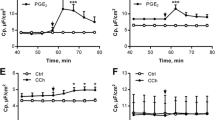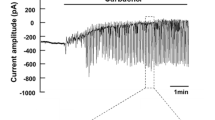Summary
We used intracellular microelectrode techniques to study the mechanisms responsible for Cl secretion by canine tracheal epithelium. Tissues were treated with indomethacin (10−6 m, added to the mucosal solution) to reduce the baseline rate of Cl secretion and then stimulated by addition of epinephrine (10−6 m) or prostaglandin E1 (10−6 m) to the submucosal solution.
Three conclusions emerged from our findings: First, secretagogues enhance the rate of transepithelial Cl transport primarily by increasing apical membrane Cl permeability, since: (i) stimulation of secretion produced parallel decreases in transepithelial resistance (R t) and the membrane resistance ratioR a/Rb, whereR a andR b refer to the resistances of the apical and basolateral membranes; (ii) there was an inverse relation between the short-circuit current andR a/Rb; (iii) secretagogues depolarized the electrical potential difference across the apical membrane (ψa) and produced an equivalent hyperpolarization of the transepithelial electrical potential difference (ψ1) so that, in the steady-state, the basolateral membrane potential (ψb) was unchanged; and (iv) substitution of sulfate or gluconate for Cl in the bathing solutions prevented secretagogue-induced changes inR t, Ra/Rb, (ψa) and (ψ1).
Second, Cl entry into the cell across the basolateral membrane appears to be electrically-neutral since omission of Cl from the submucosal solution had no effect on (ψb) and did not decreaseR a/Rb as would be expected if Cl entered the cell by a conductive process.
Third, secretagogues decreaseR b. Approximately 20 sec after the onset of the secretory responseR a/Rb underwent a secondary increase whileR t continued to fall. The decrease inR b may reflect an increase in basolateral membrane K permeability.
Similar content being viewed by others
References
Al-Bazzaz, F.J., Al-Awqati, Q. 1979. Interaction between sodium and chloride transport in canine tracheal mucosa.J. Appl. Physiol.: Respirat. Environ. Exercise Physiol. 46:111–119
Al-Bazzaz, F.J., Cheng, E. 1979. Effect of catecholamines on ion transport in dog tracheal epithelium.J. Appl. Physiol: Respirat. Environ. Exercise Physiol. 47:397–403
Al-Bazzaz, F., Yadava, V.P., Westenfelder, C. 1981. Modification of Na and Cl transport in canine tracheal mucosa by prostaglandins.Am. J. Physiol. Renal Fluid Electrolyte Physiol. 240:F101-F105
Cabantchik, Z.I., Rothstein, A. 1975. Membrane proteins related to anion permeability of human red blood cells. I. Localization of disulfonic stilbene binding sites in proteins involved in permeation.J. Membrane Biol. 15:207–226
Cohen, L.H., Mueller, A., Steinmetz, P.R. 1978. Inhibition of the bicarbonate exit step in urinary acidification by a disulfonic stilbene.J. Clin. Invest. 61:981–986
Davis, B., Ueki, I., Bruderman, I., Marin, M., Nadel, J.A. 1977. Submucosal action of furosemide on chloride ion movement across canine tracheal epithelium.Am. Rev. Respir. Dis. 115:320
Davis, C.W., Finn, A.L. 1980. Basolateral membrane resistance of toad urinary bladder is sensitive to sodium transport.J. Gen. Physiol. 76:20a
Frizzell, R.A., Field, M., Schultz, S.G. 1979a. Sodium-coupled chloride transport by epithelial tissues.Am. J. Physiol. Renal Fluid Electrolyte Physiol. 5:F1-F8
Frizzell, R.A., Smith, P.L., Vosburgh, E., Field, M. 1979b. Coupled sodium-chloride influx across brush border of flounder intestine.J. Membrane Biol. 46:27–39
Fromm, M., Schultz, S.G. 1981. Some properties of KCL filled microelectrodes.J. Membrane Biol. 62:239–244
Fromter, E., Gebler, B. 1977. Electrical properties of amphibian urinary bladder epithelia.Pfuegers Arch. 371:99–108
Gatzy, J.T., Boucher, R.C. 1979. Amphotericin B and ion flow across canine trachea.Physiologist 22:43
Gunter-Smith, P.J., Grasset, E., Schultz, S.G. 1982. Sodium-coupled amino acid and sugar transport byNecturus small intestine.J. Membrane Biol. 66:25–39
Klyce, S.D., Wong, R.K.S. 1977. Site and mode of adrenaline action on chloride transport across the rabbit corneal epithelium.J. Physiol. (London) 266:777–799
Lewis, S.A., Eaton, D.C., Diamond, J.M. 1976. The mechanism of Na+ transport by rabbit urinary bladder.J. Membrane Biol. 28:41–70
Nagel, W., Reinach, P. 1980. Mechanism of stimulation by epinephrine of active transepithelial Cl transport in isolated frog cornea.J. Membrane Biol. 56:73–79
Olver, R.E., Davis, B., Marin, M.G., Nadel, J.A. 1975. Active transport of Na+ and Cl− across the canine tracheal epitheliumin vitro.Am. Rev. Respir. Dis. 112:811–815
Schultz, S.G., Frizzell, R.A., Nellans, H.N. 1977. Active sodium transport and the electrophysiology of rabbit colon.J. Membrane Biol. 33:351–384
Smith, P.L., Welsh, M.J., Frizzell, R.A. 1982. Chloride secretion by canine tracheal epithelium. I. Role of intracellular cAMP levels.J. Membrane Biol. 70:217–226
Stutts, M.J., Boucher, R.C., Gatzy, J.T. 1980. Effects of KCl on excised canine tracheal epithelium.Physiologist 23:62
Welsh, M.J., Smith, P.L., Frizzell, R.A. 1981. Intracellular chloride activities in the isolated perfused shark rectal gland.Clin. Res. 29:480A
Welsh, M.J., Widdicombe, J.H. 1980. Pathways of ion movement in the canine tracheal epithelium.Am. J. Physiol. Renal Fluid Electrolyte Physiol. 239:F215-F221
Welsh, M.J., Widdicombe, J.H., Nadel, J.A. 1980. Fluid transport across the canine tracheal epithelium.J. Appl. Physiol. Respirat. Environ. Exercise Physiol. 49:905–909
Westenfelder, C., Earnest, W.R., Al-Bazzaz, F.J. 1980. Characterization of Na−K-ATPase in dog tracheal epithelium: Enzymatic and ion transport measurements.J. Appl. Physiol. Respirat. Environ. Exercise Physiol. 48:1008–1019
Widdicombe, J.H., Basbaum, C.B., Highland, E., 1981. Ion contents and other properties of isolated cells from dog tracheal epithelium.Am. J. Physiol. 241:C184-C192
Widdicombe, J.H., Basbaum, C.B., Yee, J.Y. 1979a. Localization of Na pumps in the tracheal epithelium of the dog.J. Cell Biol. 82:380–390
Widdicombe, J.H., Ueki, I.F., Bruderman, I., Nadel, J.A. 1979. The effects of sodium substitution and ouabain on ion transport by dog tracheal epithelium.Am. Rev. Respir. Dis. 120:385–392
Zadunaisky, J.A., Spring, K.R., Shindo, T. 1979. Intracellular chloride activity in the corneal epithelium.Fed. Proc. 38:1059
Author information
Authors and Affiliations
Rights and permissions
About this article
Cite this article
Welsh, M.J., Smith, P.L. & Frizzell, R.A. Chloride secretion by canine tracheal epithelium: II. The cellular electrical potential profile. J. Membrain Biol. 70, 227–238 (1982). https://doi.org/10.1007/BF01870565
Received:
Revised:
Issue Date:
DOI: https://doi.org/10.1007/BF01870565




